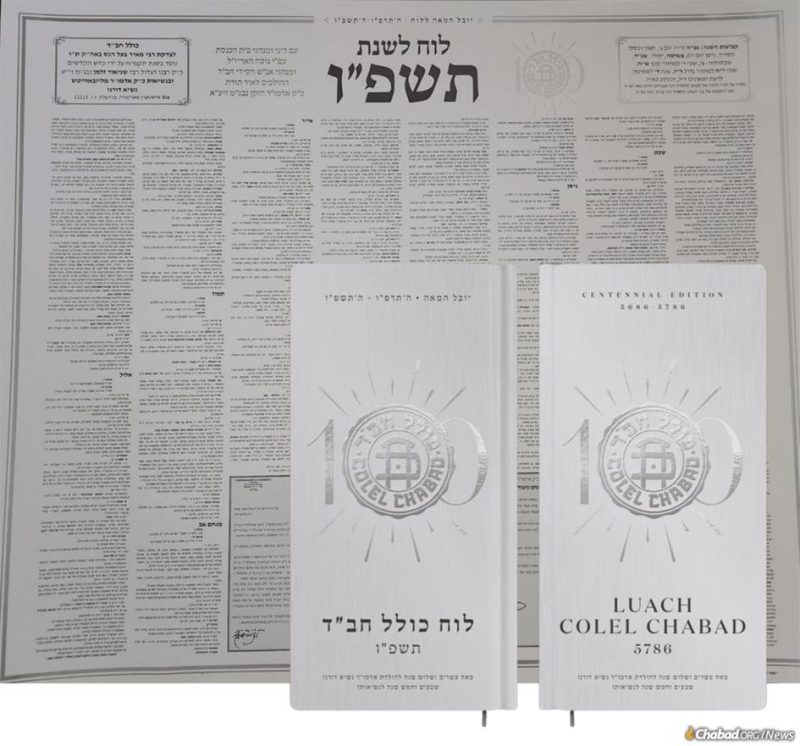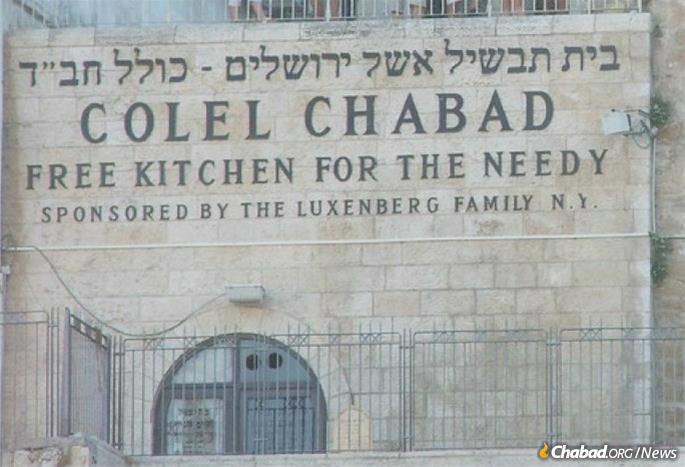
After a Century of Guiding Jewish Life, Iconic Luach Colel Chabad Turns 100
by Mendel Scheiner – chabad.org
The famed Luach Colel Chabad is marking its 100th anniversary.
The Luach, the Hebrew word for calendar, is more than just that, the Jewish calendar being an essential guide to day-to-day life as a Jew. For a century the Luach Colel Chabad has weaved together the calendar, customs, Halachic times, holidays and the teachings of the Rebbes of Chabad-Lubavitch, becoming a staple in thousands of Jewish institutions, communities and homes.
Nowadays, the annual calendar is published in two formats: an oversized wall poster for use in synagogues, and as a slim booklet for individual use.
On top of featuring all the essentials needed for a Jewish calendar, including Shabbat, Jewish holiday, and Rosh Chodesh [new month] dates and times, the Luach is packed with the Jewish laws and practices of each day of the year, along with the definitive Chabad customs on how to approach each particular practice. Also highlighting special occasions on the Chassidic calendar and teachings, the Luach is published by Colel Chabad, the longest operating charity in Israel, which was founded in 1788 by the first Chabad Rebbe, Rabbi Schneur Zalman of Liadi, known as the Alter Rebbe.
To celebrate the milestone, Colel Chabad has prepared a special centennial edition of their iconic calendar.
The Luach Colel Chabad held deep personal significance for the Rebbe—Rabbi Menachem M. Schneerson, of righteous memory. It is said that the Luach was frequently on the Rebbe’s desk. The Rebbe would review it regularly, even making occasional edits for its publishers. “We see how much it meant to the Rebbe, through his consistent instruction to follow the Luach’s guidance throughout the year,” explains Rabbi Shmuel Lipskar, an administrator at Colel Chabad.
During a public talk on Rosh Hashanah 5752 (1991), the Rebbe emphasized that the Luach was crucial for those, who, at times, might not have access to rabbinic authority. “Through careful reading of these calendars, such as the Luach Colel Chabad, which contains the relevant customs and laws, one can easily find guidance. It is thus recommended that everyone peruse these calendars and engrave in their minds the laws relevant to these days, since sometimes, when a question arises, it is at a time when we may not interrupt prayers to ask, or there is no competent authority to ask; sometimes, indeed, one may not know that there is something to ask… [The publishers] deserve our thanks.”

Two Centuries of Service
In 1777, Rabbi Menachem Mendel of Horodok led a group of nearly 300 Chassidim from Eastern Europe on a journey to settle in the Land of Israel. Life in the Galilee, however, brought famine; crushing taxes from the Holy Land’s colonial overlords, the Ottoman empire; and hostility from neighbors. In their distress, the spirited immigrants turned to their brethren abroad for help.
In response, the Alter Rebbe founded Colel Chabad in 1788.
Established as a lifeline for the Chassidim, Colel Chabad’s remit has broadened extraordinarily. Over the years, the Israeli government has partnered with Colel Chabad on many programs to help Israel’s most vulnerable families access healthier food and sustain themselves financially.
Colel Chabad, today the oldest continuously operating charity in the Land of Israel, was already a long-established charity in 1924, , when the young, brilliant Halachic authority Rabbi Avraham Chaim Naeh (1890-1954)—whose Ketzot Hashulchan commentary on the Alter Rebbe’s foundational Shulchan Aruch was first published in 1926—walked into its offices in the Meah She’arim neighborhood of Jerusalem. The son of the organization’s administrator, Rabbi Menachem Mendel Naeh, the rabbi had long been active in its work.
Upon entering, the younger Rabbi Naeh, who also served as the secretary of the Eida Charedit in Jerusalem, noticed Rosh Hashanah letters to donors and supporters being prepared to be sent along with the ‘Luach Eretz Yisrael’ calendar. Concerned, he asked how a Luach that differed so greatly from the Chassidic customs could be sent to Chassidic institutions and homes worldwide. This was not just a matter of loyalty.
For millenia, the new Jewish month began with the first sighting of the smallest crescent moon, which was determined by the Great Sanhedrin in Jerusalem upon the testimony of two eyewitnesses. In anticipation of the disbandment of the Sanhedrin, in the 4th Century CE Hillel II and his rabbinical court established a perpetual calendar on a 19-year cycle, each cycle containing seven leap years.
Besides for calculating dates—how does one know when in time a holiday begins without an accurate Jewish calendar?—Jewish calendars provide its users with Halachic times denoting the start and end times of Shabbat and holidays, likewise requiring complicated calculations, equations for which differ based on various Halachic opinions. Providing Chassidim with a calendar that did not follow Chassidic customs was no small matter.

The Colel Chabad worker told Rabbi Naeh that they had no alternative calendar. It was then that Rabbi Naeh resolved to spearhead the creation of the first Chabad-Lubavitch Luach. This was not the first calendar he created: Rabbi Naeh had previously served as the rabbi of Samarkand, Bukhara, where he’d been sent as an emissary by the fifth Chabad Rebbe, Rabbi Sholom Dovber Schneersohn, and in that position had created a calendar for his distant community for 1914-1915. Rabbi Naeh had mastered the Bukharian language during his tenure there, and written customs and practices for the year in Bukharian in that previous calendar. After much research and work to definitively catalog Chabad customs for holidays and special days throughout the year, the inaugural print of the Luach Colel Chabad was released 100 years ago, in time for Rosh Hashanah 5686 (1925).
Users were able to quickly consult the Luach to explain on how they were to approach each day of the year. Torah readers in synagogues could quickly consult it to know what the Chabad approach was to reading Torah portions where Chassidic customs differ from others, and how Chabad recites Haftorahs when Shabbats fall out on holidays and Rosh Chodesh. Cantors checked the Luach ahead of the High Holidays to see which liturgical poems inserted at various points of prayer are meant to be recited, and which are not, while individuals used it to see how they were to prepare for holidays and special days on the Chassidic calendar.
Originally designed as an oversized wall calendar that was hung in synagogues, Colel Chabad began publishing the Luach in booklet form for convenient use later on, which has been enthusiastically embraced for decades.
“Beyond its practicality as a guidebook for daily Jewish living, the Luach embodies the continuity of the Alter Rebbe’s and the Rebbe’s customs, year after year,” Lipskar told Chabad.org. “The 100th anniversary of the Luach is not only a milestone in time, but also a celebration of the continued teachings of our Rebbeim, handed from generation to generation.”












